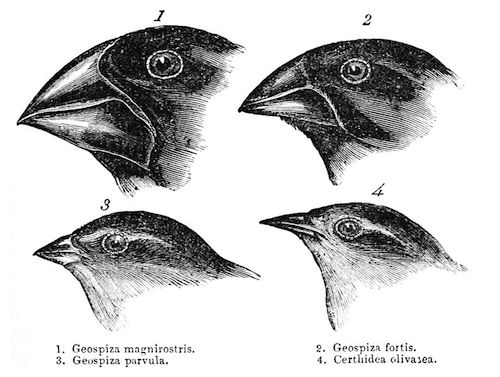 Evolution
Evolution
 Intelligent Design
Intelligent Design
Darwin’s Finches Show Rule-Constrained Variation in Beak Shape

A simple yet powerful mathematical rule controls beak development, Harvard scientists find, while simultaneously preventing beaks from evolving into something else. This adds more design punch to Casey Luskin’s recent rebuttal of Pigliucci’s defense of Icon of Evolution #7, Darwin’s finches.
The Harvard Gazette presents findings of a new study by evolutionary biologist Arkhat Abzhanov and mathematician Michael Brenner. They looked at how developmental mechanisms both allow for great variability and create powerful constraints on the shape of the beaks of songbirds. While they apparently give no evidence for doubting neo-Darwinism in a general sense, what they found is not the usual Darwinian story:
Evolutionary biologists have long held up songbirds, particularly the Galapagos finches first described by Charles Darwin, as an example of natural selection at work. In order to exploit different environments and food sources, the birds developed a startling variety of beak shapes — from short, blunt beaks ideal for cracking seeds and nuts to long, slender beaks designed to sip nectar from flowers. The assumption was that natural selection was the primary, if not the sole, cause for the variation.
But while that variation can be tied, in part, to the way the beaks develop, Harvard researchers say that common developmental mechanism is also a powerful constraint on new beak shapes. (Emphasis added.)
Instead of using Darwin as a source, Abzhanov and Brenner turned to Scottish mathematician D’Arcy Thompson, father of geometric morphometrics and a Darwin critic. Thompson’s 1917 book On Growth and Form relegated natural selection to a secondary role; to him, mathematical laws were primarily responsible for biological structures. His view has been termed structuralism: the belief that biological forms are best explained by law-like processes.
In that tradition, the two Harvard professors uncovered a non-random process — mathematics — at work in beak development, not an unguided process like natural selection.
"What it shows is that the variations in beak shapes are far from random — the birds are using these specific geometric transformations to produce morphological diversity," Abzhanov said. "With just two mathematical transformations, we can show how all the diversity across these species can be related."
All the fantastic variation in songbird beaks can be described mathematically, they say, as a basic cone shape environmentally modified by two transformations: scaling and shear. Those factors are applied in a uniform developmental process common to all songbirds.
As cell division begins in a "growth zone" in the embryo where the beak will take shape, processes governed by these mathematical transformations ensure it will turn out with the correct shape. This has the effect of limiting the amount of variability:
Through modeling, Abzhanov and Brenner were able to show that, for a beak to maintain the conical shape created by the growth zone during development and still obey the rules of scaling and shear transformations during evolution, the growth zone must decay at a particular rate. Tests using embryos of zebra finches showed the predictions made by their model to be accurate.
"Thus, most or all songbirds out there in nature, so remarkably diverse and distinct, are united by this particular rule, when we observe a two-tier variation in their beak shapes with scaling and shear transformations explaining their origins," Abzhanov said. "These birds all have conical-shape bills constructed in a certain way, and this creates a paradox in the entire process of their beak evolution when there is both flexibility and powerful constraints."
This is very different from neo-Darwinism. Darwin taught that all the variety in the natural world could be explained by random variation and natural selection — processes that are thoroughly unguided and aimless. What these Harvard biologists found were mathematical rules that put limits on what can evolve. The "powerful constraints" they found, that they were able to model mathematically, contain enough flexibility to allow birds to adapt to the food available, but keep them "united" as birds by a "particular rule."
This sounds like design. We find in Darwin’s finches (and all songbirds) an internal system, controlled by a non-random developmental process. It is flexible enough to allow for variation, but powerful enough to constrain the beak to its basic form (a conical shape modulated by scaling and shear) so that the rest of the bird’s structures are not negatively affected. Beak development is controlled by a decay process that must operate at a particular rate. It’s all very precise, so much so that it could be modeled mathematically.
What Darwinian explanation can make meaningful predictions? These scientists tested their model, and "showed the predictions made by their model to be accurate."
The very birds that have long been used as iconic examples of natural selection become, on closer examination, paragons of intelligent design.
Image source: Wikipedia.
